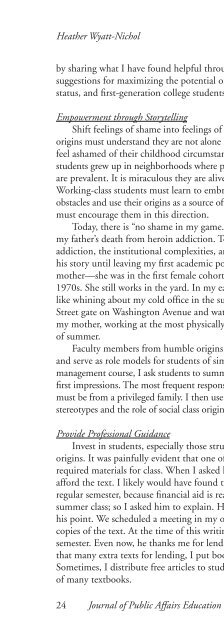WINTER 2012 - National Association of Schools of Public Affairs and ...
WINTER 2012 - National Association of Schools of Public Affairs and ...
WINTER 2012 - National Association of Schools of Public Affairs and ...
You also want an ePaper? Increase the reach of your titles
YUMPU automatically turns print PDFs into web optimized ePapers that Google loves.
Cheryl Simrell King<br />
Yet, no matter how much we deny class, our denial does not change the<br />
facts. There are different classes in the United States, <strong>and</strong> the gap between the<br />
classes is growing, not contracting. 1 Even with astronomical income inequality,<br />
Americans at all income levels incorrectly identify themselves as the ubiquitous<br />
“middle class.” Estimates from polls indicate that perceived middle-class annual<br />
household income ranges in the United States from $25,117 to $100,466<br />
(e.g., see Pew Research Center’s 2008 survey results at http://pewsocialtrends.<br />
org/2008/04/09/inside-the-middle-class-bad-times-hit-the-good-life/). Clearly,<br />
people at the lower <strong>and</strong> upper levels <strong>of</strong> this range live very differently. Yet, we<br />
convince ourselves we are all in the middle, a lie that allows us to continue<br />
believing in the American Dream.<br />
The myth <strong>of</strong> the American Dream insists that anyone born without<br />
privilege, no matter their life circumstances, can rise above the poor, nasty,<br />
brutish, <strong>and</strong> short lives fate deals them. At the heart <strong>of</strong> the American Dream is<br />
the presumption <strong>of</strong> equality <strong>of</strong> access to things that allow non-privileged folks to<br />
“pull ourselves up by our bootstraps” <strong>and</strong> change our circumstances, including<br />
education, working transportation options, health care, asset-building programs,<br />
information, <strong>and</strong> technology.<br />
What Is Class?<br />
Think about how people use the word class. Someone is “classy” if they show markers <strong>of</strong><br />
upper class: elegant, tasteful, refined, <strong>and</strong> sophisticated. The opposite <strong>of</strong> classy is “tacky”:<br />
cheap, vulgar, shabby, <strong>and</strong> in bad taste. Obviously, being classy is preferred to being<br />
tacky, thus showing our cultural preference for upper-class <strong>and</strong> upper-class markers even<br />
as we deny that class is something important, or significant, in our culture.<br />
When we meet strangers, we automatically note their sex/gender <strong>and</strong> race,<br />
mostly subconsciously. We also notice their social class markers, that is, their<br />
dress, hairstyle, speech patterns <strong>and</strong> language, the condition <strong>of</strong> their teeth,<br />
the car they drive, where they grew up, the schools they attended, <strong>and</strong> so on<br />
(G<strong>of</strong>fman, 1959; Yoshino, 2006), <strong>and</strong> interact with others differently depending<br />
on which <strong>of</strong> various categories she or he occupies. Yet, we pretend we are all the<br />
same, more or less, equal in a l<strong>and</strong> <strong>of</strong> inequalities (Hochschild, 1995; Kliman &<br />
Madsen, 1999; Ostrove & Cole, 2004).<br />
Our models <strong>of</strong> class-based societies stem from our mainstream European<br />
origins, where class is a relatively fixed phenomenon that determines a person’s<br />
potential <strong>and</strong> possibilities. In the United States, we tell ourselves class is not<br />
static, it is fluid. Anyone can jump the fluid class boundaries, although the<br />
presumption is that we will jump up, not down (a belief being sorely tested<br />
in the current economic recession). These strong beliefs about the fluidity <strong>of</strong><br />
class <strong>and</strong> strong beliefs about meritocracy lead people to individual, rather than<br />
structural, causal attributions for social class (Langston, 1992, cited in Ostrove &<br />
Cole, 2003; Ostrove & Cole, 2003). As Ostrove <strong>and</strong> Cole explain:<br />
52 Journal <strong>of</strong> <strong>Public</strong> <strong>Affairs</strong> Education

















